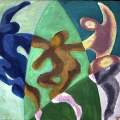I was recently able to catch up with fellow Living Schooler and new friend Mark Longhurst. I met Mark while picking him up for the Wild Goose Festival this past summer, and was immediately struck by his pastoral heart, alive mind, twin passions for liberating action and contemplative practice – as well as his excellent taste in craft beer. 🙂
When Mark wanted to talk to me about the recently-released Divine Dance I was able to work on with Fr. Richard Rohr, I jumped at the chance. What follows is the first part of our conversation, with a link to his blog – Ordinary Mystic – to our full conversation. If you don’t already, I highly recommend you subscribe to his email newsletter and follow the blog on Facebook so you don’t miss any of his excellent posts on the intersection of deep-dive spirituality and everyday life.
Ordinary Mystic: Besides the obvious unique and exciting opportunity of working with Richard Rohr, why did you want to write a book on the Trinity?
Mike Morrell: I spent my formative years in Presbyterian, Baptist, and Pentecostal churches – spaces which, by default, seemed to emphasize only one aspect of God or ‘person’ of Trinity – Father, Son, and Spirit, respectively. Something always seemed missing in these lop-sided omissions, and sectarian distortion was the result.
These half-baked ideas, and collectively-generated experiences, of Divinity are falling increasingly flat, both for people who grew up in church like me as well as those without religious backgrounds whatsoever. Both of these groups are feeding into the growing identification of the spiritual-but-not-religious, or The Nones.
Thankfully, when I began discovering the contemplative path – through my involvement with a particular stream in the house church movement, interestingly enough – I was introduced to a holistic interplay between these aspects of divinity that felt promising.
On top of this, nearly a decade ago, two influences came into my life that gave my Trinitiarian spirituality an upgrade: a rough manuscript of a soon-to-be-released novel called The Shackthat I was asked to consider for the blogger network I curated, today known as Speakeasy, and two powerful conference recordings by Fr. Richard Rohr – The Divine Dance: Exploring the Mystery of Trinity and The Shape of God: Deepening the Mystery of Trinity, the latter featuring Cynthia Bourgeault as well.
Ordinary Mystic: The title is memorably titled The Divine Dance. Can you explain why?
Mike Morrell: I sure can. While the dynamic of Trinity is present in Scripture throughout its pages, with its ascribing of divinity to a divine Source, the incarnate Son, and the outpoured and indwelling Spirit, Scripture never names this dynamic explicitly. It can be seen in Scripture’s doxology, but not in summary. (And of course, very little in Holy Writ is summarized in ways that satisfy modern sensibilities.)
In fourth century in Central Anatolia (today Turkey), though, new language began to emerge. There was this fertile community of mystical theologians, practitioners, and leaders known as the Cappodocian fathers: Basil ‘the Great,’ his little brother Gregory of Nyssa, and their close friend, Gregory of Nazianzus. There was also a ‘Cappadocian mother,’ Macrina ‘the Younger,’ Basil and Gregory of Nyssa’s sister. The Cappadocian teachers witnessed the dynamism of Trinity in their lives and the testimony of our sacred writings, and borrowed a term from arts and culture to describe this dynamic movement – perichoresis, which literally means circle dance.
Trinity, in this articulation, has less to do with an overly-technical attempt to delineate the inner or manifestational life of the Godhead, and far more an expression of beauty and process – saying something about the relationship itself.
As Richard mentions in the book, if someone in the 21st century had just come out of thin air and said “God is a Circle Dance,” guardians of orthodoxy would likely be jumping all over themselves to label as ‘fringe’ or ‘new age.’ But the Cappadocians – and St Athanasius who proceeded from them – are the very definition of orthodoxy in the early ecumenical church!
Which tells me that maybe we should cut today’s contemporary mystic-theologians more slack as we continue to give language to the un-languagable.
The conversation continues over at Ordinary Mystic!
Related Posts from Mark:







When your heart resonates deeply with every page turned you know the book in your hands is something special. }:- ❤️
http://www.thedivinedance.org
Hoofnote: The pages are rapidly filling up with notes.